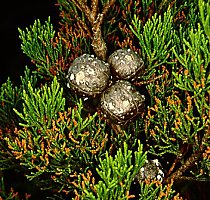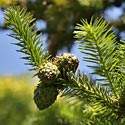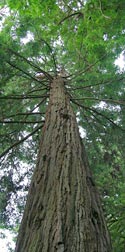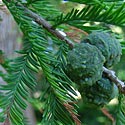|
Family: Cupressaceae
[= Taxodiaceae]
Life
> eukaryotes >
Archaeoplastida >
Chloroplastida
>
Charophyta > Streptophytina > Plantae (land plants)
> Tracheophyta (vascular plants) > Euphyllophyta > Lignophyta (woody plants) > Spermatophyta (seed plants)
> Gymnospermae >
Coniferophyta
About 16 genera and 115 species (cosmopolitan),
of which two genera and four species are native to southern
Africa. In addition, Cupressus arizonica and Juniperus
virginiana have become naturalised in this region.
Genera indigenous to southern Africa
Information from Glen (2000).
|
Juniperus
About 60 species (mainly temperate and
subtropical regions of the northern hemisphere). One
species, Juniperus procera (African juniper), is
native to southern Africa where it is found in the
Eastern Highlands of Zimbabwe. In addition, Juniperus virginiana
(Red cedar) has become
naturalised in the Free State where it invades
grassland, river banks and rocky outcrops. The leaves of
this species are toxic to livestock and are a skin
irritant to humans (Palgrave and Palgrave 2002).
An additional 17 species of Juniperus have been cultivated in
southern Africa. |
|
|
Widdringtonia
Three species, two of which are
endemic to southern Africa and the third has a
distribution extending from southern Africa into
tropical regions further north. |
 |
Genera naturalised in southern Africa
|
* Cupressus
About 13 species (warm, north
temperate regions), of which one, Cupressus arizonica,
has become naturalised in the Free State and the Eastern
Cape. Including this species, 10 species
have been cultivated in southern Africa. |
|
Other genera, cultivated in southern Africa
Information from Glen (2002). Species are
listed for genera with only one species cultivated in southern
Africa.
|
Callitris
Eight species cultivated. |
|
|
Calocedrus decurrens
(Incense-cedar)
Native to
the western USA. |
|
|
Chamaecyparis
Six species cultivated. |
|
|
Cryptomeria japonica (Japanese
cedar)
Native to China and Japan. The
genus was formerly placed in the Taxodiaceae. |
|
|
Cunninghamia
lanceolata (Chinese fir)
Native to China, Vietnam, Laos,
and possibly Cambodia. . The genus was formerly
placed in the Taxodiaceae. |
 |
|
Glyptostrobus lineatus (Chinese
swamp cypress)
Native to southern China. The
genus was formerly placed in the Taxodiaceae. |
|
|
Libocedrus
Two species cultivated: Libocedrus
bidwillii (Pahautea, Kaikawaka) and Libocedrus
plumosa (Kawaka), both of which are native to
New Zealand. |
|
|
Metasequoia glyptostroboides
(Dawn redwood)
Native to China. The genus was
formerly placed in the Taxodiaceae. |
|
|
Platycladus orientalis (Chinese
arborvitae)
Native to N China. |
|
|
Sciadopitys verticillata
(Japanese umbrella pine)
Native to Japan. The genus was
formerly placed in the Taxodiaceae. |
|
|
Sequoia sempervirens (Californian redwood)
Native to a narrow fog belt on the
west coast of the USA, extending from Monterey County in
California to southern Oregon. The species holds the
record as the tallest living thing on earth with
specimens reaching 115.5 m in height. The genus
was formerly placed in the Taxodiaceae. |
 |
|
Sequoiadendron giganteum (Giant
redwood, Mammoth tree)
Native to California, USA. The
genus was formerly placed in the Taxodiaceae. |
|
|
Taxodium distichum (Swamp
cypress, Bald cypress)
A large tree native to the USA, Mexico and
Guatemala. Cultivated as an ornamental tree in
southern Africa. Within its native distribution, it is
usually found in swampy conditions but under cultivation
it is also able to thrive in well-drained soils. It is
called the Bald cypress because it is deciduous, loosing
its leaves in winter. The genus was formerly placed in the
Taxodiaceae. |
 |
|
Tetraclinis articulata (Alerce)
Native to Spain,
Malta and North Africa. |
|
|
Thuja
Two species cultivated: Thuja
occidentalis (American arborvitae) from the E USA
and Thuja plicata (Giant arborvitae) from the W USA. |
|
|
Thujopsis dolabrata (False
arborvitae)
Native to
Japan. |
|
Publications
-
Glen, H.F. 2000. Cupressaceae. In: Seed Plants of
Southern Africa (ed. O.A. Leistner). Strelitzia 10: 29-30.
National Botanical Institute, Pretoria.
-
Glen, H.F. 2002. Cultivated Plants of
Southern Africa. Jacana, Johannesburg.
- Palgrave, K.C. and Palgrave, M.C. 2002. Trees of Southern Africa. 3rd
Edition. Struik Publishers, Cape Town.
|
